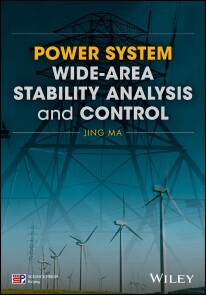Power System Wide-area Stability Analysis and Control
eBook
Bibliographische Informationen
Format: EPUB
Digitale Rechteverwaltung: Adobe DRM
Beschreibung
An essential guide to the stability and control of power systems integrating large-scale renewable energy sources
The rapid development of smart grids and the integration of large scale renewable energy have added daunting new layers of complexity to the long-standing problem of power system stability control. This book offers a systematic stochastic analysis of these nonlinear problems and provides comprehensive countermeasures to improve power system performance and control with large-scale, hybrid power systems.
Power system stability analysis and control is by no means a new topic. But the integration of large scale renewable energy sources has added many new challenges which must be addressed, especially in the areas of time variance, time delay, and uncertainties. Robust, adaptive control strategies and countermeasures are the key to avoiding inadequate, excessive, or lost loads within hybrid power systems. Written by an internationally recognized innovator in the field this book describes the latest theory and methods for handling power system angle stability within power networks. Dr. Jing Ma analyzes and provides control strategies for large scale power systems and outlines state-of-the-art solutions to the entire range of challenges facing todays power systems engineers.
Features nonlinear, stochastic analysis of power system stability and controlOffers proven countermeasures to optimizing power system performanceFocuses on nonlinear time-variance, long time-delays, high uncertainties and comprehensive countermeasuresEmphasizes methods for analyzing and addressing time variance and delay when integrating large-scale renewable energyIncludes rigorous algorithms and simulations for the design of analysis and control modelingPower System Wide-area Stability Analysis and Control is must-reading for researchers studying power system stability analysis and control, engineers working on power system dynamics and stability, and graduate students in electrical engineering interested in the burgeoning field of smart, wide-area power systems.
Autorenportrait
JING MA, PhD, is a professor in the School of Electrical and Electronic Engineering at North China Electric Power University, Beijing, China. He is a lead member of the National Science and Technology Support Program of China and a consultant with the China Electric Power Research Institute. Dr. Ma pioneered the application of Guardian Map Theory, Perturbation Theory, and the Markov model for the analysis of large time-varying, strong time-delay and high uncertainties into power system stability analysis process. He has innovated robust and adaptive control strategies using Federated Kalman Filters, Dual Youla Parameterization and Classification and Regression Tree to establish a wide-area control system with high accuracy and efficiency.
Inhalt
About the Author ix
Preface xi
1 Basic Theories of Power System Security Defense 1
1.1 Introduction 1
1.2 Power System Reliability and Stability 2
1.2.1 Reliability of Power System 2
1.2.2 Stability of Power System 4
1.3 Three Defense Lines in the Power System 7
1.3.1 Classification of Disturbance in the Power System 7
1.3.2 Power System Operation State 8
1.3.3 Three Defense Lines in Power System Stability Control 10
1.3.4 Functions of Defense System 12
1.4 Summary 15
References 15
2 Power System Analysis and Control Theory 17
2.1 Introduction 17
2.2 Mathematical Model of Power System 17
2.2.1 Mathematical Model of Synchronous Generator 17
2.2.2 Mathematical Model of Excitation System 22
2.2.3 Mathematical Model of Prime Mover and Speed Governor 24
2.2.4 Mathematical Model of Load 27
2.3 Power System Stability Analysis Method 29
2.3.1 TimeDomain Simulation Method 29
2.3.2 Eigenvalue Analysis Method 31
2.3.3 Transient Energy Function Method 33
2.4 Automatic Control Theory 33
2.4.1 Classical Control Theory 34
2.4.2 Modern Control Theory 35
2.4.3 Large System Theory and Intelligent Control Theory 36
2.5 Summary 38
References 38
3 WideArea Information Monitoring 41
3.1 Introduction 41
3.2 Test System 41
3.2.1 FourGenerator TwoArea System 41
3.2.2 SixteenGenerator System 42
3.2.3 Western Electricity Coordinating Council 43
3.3 Optimal Selection of WideArea Signal 44
3.3.1 WideArea Signal Selection Method Based on the Contribution Factor 44
3.3.2 Simulation Verification 48
3.4 Optimal Selection of WideArea Controller 57
3.4.1 Mathematical Background 57
3.4.2 Example Test System 62
3.4.3 GPSS Based on Collocated Controller Design 63
3.4.4 Testing Results and Analysis 64
3.5 Summary 70
References 71
4 Stability Analysis of Stochastic System 73
4.1 Introduction 73
4.2 Stability Analysis of Stochastic Parameter System 74
4.2.1 Interval Model and SecondOrder Perturbation TheoryBased Modal Analysis 74
4.2.2 Power System SmallSignal Stability Region Calculation Method Based on the Guardian Map Theory 82
4.3 Stability Analysis of Stochastic Structure System 102
4.3.1 ModelTrajectoryBased Method for Analyzing the Fault System 102
4.3.2 Angle Stability Analysis of Power System Considering Cascading Failure 119
4.4 Stability Analysis of Stochastic Excitation System 137
4.4.1 Model of Multiple Operating Conditions System Considering the Stochastic Characteristic of Wind Speed 137
4.4.2 Simulation Analysis 146
4.5 Summary 152
References 153
5 Stability Analysis of TimeDelay System 155
5.1 Introduction 155
5.2 Stability Analysis of a NonJump TimeDelay System 156
5.2.1 Stochastic Stability Analysis of Power System with Time Delay Based on Itô Differential 156
5.2.2 Stochastic TimeDelay Stability Analysis of a Power System with Wind Power Connection 168
5.3 Stability Analysis of a Jump TimeDelay System 182
5.3.1 Jump Power System TimeDelay Stability Analysis Based on Discrete Markov Theory 182
5.3.2 TimeDelay Stability Analysis of Power System Based on the Fault Chains and Markov Process 196
5.4 Summary 208
Appendix A 209
References 210
6 WideArea Robust Control 213
6.1 Introduction 213
6.2 Robust Control for Internal Uncertainties 214
6.2.1 Multiobjective Robust H 2 /H Control Considering Uncertainties for Damping Oscillation 214
6.2.2 Robust H 2 /H Control Strategy Based on Polytope Uncertainty 221
6.3 Optimal Robust Control 226
6.3.1 WideArea Damping Robust Control Based on Nonconvex Stable Region 226
6.3.2 WideArea Damping Robust H 2 /H Control Strategy Based on Perfect Regulation 236
6.4 Error Tracking Robust Control 243
6.4.1 Control Algorithm 245
6.4.2 Simulation Verification 248
6.5 Summary 251
References 252
7 WideArea Adaptive Control 253
7.1 Introduction 253
7.2 Adaptive Control Considering Operating Condition Identification 254
7.2.1 Federated Kalman Filter Based Adaptive Damping Control of InterArea Oscillations 254
7.2.2 Classification and Regression Tree Based Adaptive Damping Control of InterArea Oscillations 268
7.3 Adaptive Control Considering Controller Switching 288
7.3.1 Dual Youla Parameterization Based Adaptive WideArea Damping Control 288
7.3.2 Continuous Markov Model Based Adaptive Control Strategy for TimeVarying Power System 303
7.3.3 Discrete Markov Model Based Adaptive Control Strategy of MultipleCondition Power System 318
7.3.4 Adaptive Controller Switching Considering Time Delay 327
7.4 Summary 339
References 340
Index 341
E-Book Informationen
Um die PocketBook Cloud zu aktivieren, loggen Sie sich bitte in Ihrem Kundenkonto ein und gehen dort in den Bereich „E-Books“. Setzen Sie hier einen Haken bei „Neue E-Book-Käufe automatisch zu meiner Cloud hinzufügen.“. Dadurch wird ein PocketBook Cloud Konto für Sie angelegt. Die Zugangsdaten sind dabei dieselben wie die Ihres Kundenkontos in diesem Webshop.
Weitere Informationen zur PocketBook Cloud finden Sie unter www.meinpocketbook.de.
Allgemeine E-Book-Informationen
E-Books in diesem Webshop können in den Dateiformaten EPUB und PDF vorliegen und können ggf. mit einem Kopierschutz versehen sein. Sie finden die entsprechenden Informationen in der Detailansicht des jeweiligen Titels.
E-Books ohne Kopierschutz oder mit einem digitalen Wasserzeichen können Sie problemlos auf Ihr Gerät übertragen. Sie müssen lediglich die Kompatibilität mit Ihrem Gerät prüfen.
Um E-Books, die mit Adobe DRM geschützt sind, auf Ihr Lesegerät zu übertragen, benötigen Sie zusätzlich eine Adobe ID und die kostenlose Software Adobe® Digital Editions, wo Sie Ihre Adobe ID hinterlegen müssen. Beim Herunterladen eines mit Adobe DRM geschützten E-Books erhalten Sie zunächst eine .acsm-Datei, die Sie in Adobe® Digital Editions öffnen müssen. Durch diesen Prozess wird das E-Book mit Ihrer Adobe-ID verknüpft und in Adobe® Digital Editions geöffnet.
Weitere Artikel aus der Kategorie "Technik/Wärmetechnik, Energietechnik, Kraftwerktechnik"
Noch nicht lieferbar

Noch nicht lieferbar

Sofort Lieferbar

Sofort Lieferbar

Lieferbar innerhalb 1 - 2 Wochen








